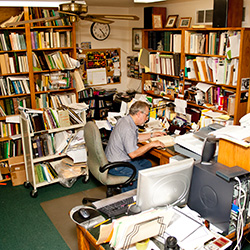
By employing information found within the pages of “dated” texts, gardeners can find much greater success.
Even as the worldwide economy was contracting in recent years, seed orders to both mail-order and on-line seed companies continued to grow as much as 30 percent per year. From a postage-stamp raised bed in a backyard to large family production gardens, people today are growing more of their own food. This phenomenon is not unique, however; similar events occurred about a century ago.
Mile Wide, Inch Deep
From the 1890s to the 1920s, seed companies grew and prospered as home ownership and the suburbs of America expanded hand in hand. People wanted the fresh taste of fruits and vegetables that they remembered from their grandparents’ farms and gardens. Seed sales dropped off rather quickly, however, when people became a half-generation removed from rural life. Folks simply did not have the growing skills to be successful producing the broad range of foods they remembered.
W. Atlee Burpee, J.J.H. Gregory and others solved this problem by publishing books on growing specific types of vegetables. The cause was further expanded by the Orange Judd Publishing Company; instead of mere pamphlets with broad, sweeping generalizations, their books were very specific production guides. These guides provided detailed information about the cost of production, climate, soil fertility, growing, transplanting, insects, diseases and expected yields. Information on seed varieties, as well as their origin and development, was often included.
Today, we find ourselves in the same vacuum of information those publishers tried to dispel. As many folks try their hand at backyard food production, they meet with limited success from the “big box” store transplants and seed rack packets, as the efforts required don’t seem to measure up to the remembered joys of vegetable gardening. Unfortunately, going to the library or the gardening section of a bookstore may only lead to frustration.
Three popular, current gardening books—all from very good publishers—contain the following information for specific vegetable production: two to four pages on most popular vegetables, up to eight pages on bean production, including bush, pole, lima and dry varieties... and that’s it! There are generalizations for all vegetables included for plant disease and insect pests, but no specific information for specific vegetables.
Lessons From the Past
In contrast, Bean Culture by Glenn Sevey, published in 1907 and still in print as late as 1920, contains 130 pages of very detailed information on the olericulture of beans. (Olericulture can be defined as the cultivation of vegetables for the home or market.) The author offers the gardener six pages of information about general conditions that affect the growth of beans, as well as 20 pages on insects and disease, with illustrations that greatly benefit gardeners of all levels of experience. He even cautions the reader about beans and their preferred geographic areas for maximum success in production. While its overall tone is aimed at those engaged in field production, gardeners with any size of plot will benefit greatly from this book—there is absolutely nothing “modern” that can match the information it provides.
Another book that will greatly assist vegetable gardeners is A.G.B. Bouquet’s Cauliflower and Broccoli Culture. Published in 1929 with 125 pages, this book provides the vegetable grower with sufficient information to produce respectable heads of both crops. One of the real tricks to producing cauliflower, we learn, is that two-year-old seed will produce larger heads than “new” seed. Broccoli is easier to grow, and much of the book discusses similar methods that will succeed with this crop.
It does not require too many vines, and only a small space, to produce enough sweet potatoes to stock a root cellar or candy for Thanksgiving dinner. James Fitz’s Sweet Potato Culture, first published in 1886 and still available more than 30 years later, contains 86 pages of techniques for anyone to be successful in growing this amazing and tasty root crop. All the necessary tips for slip production, fertilization and care through the growing season are clearly explained.
As a bookseller with over 25 years of experience with olericultural books—and as an organic farmer and gardener for the past 20 years—I’m concerned when I think about home gardeners as they try to bring a crop full circle, from seed to table, with only a few pages of very general information to guide them. Trying to grow food for the table today, using only the books currently available, can ultimately lead to frustration and disappointment. By employing the information found within the pages of these “dated” texts, however, gardeners are certain to find much greater success and satisfaction when putting food on the table. iBi
D. Keith Crotz is the founder and owner of The American Botanist, booksellers based in Chillicothe. For more information, call (309) 274-5254 or visit amerbot.com.

